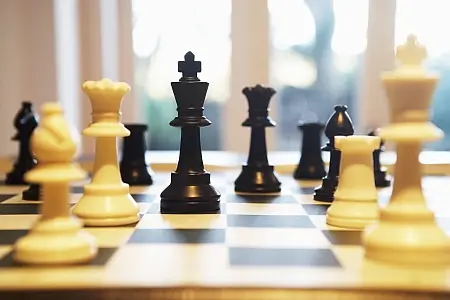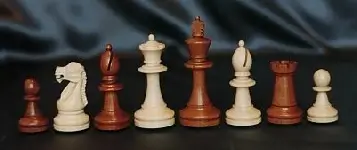About chess
The origins of chess
by Sarah Beth
Take out your chessboard!
Pick up a piece, say the Queen. Hold her in your hand.
Feel her weight, her texture, study her features.
Look at your board. The "64 square jungle" as Kasparov called it
The pieces, the board, the moves, the strategies and tactics...
They seem so ancient, so immutable...
Yet...
Chess, as we know it today, didn't exist until about 1475!

What happened in 1475? Until then, there was no Queen... The King had a counselor who could move diagonally one square at a time. One other major difference concerned promotion. A pawn, reaching the 8th rank, could only become a counselor.
Around 1475, the counselor underwent a sex-change and emerged as the powerful Queen with whom we are all familiar. Promotion rules changed to the modern European version. Another factor played an important role in stabilizing chess at this point in time: the printing press! Books were written and more freely distributed and within 100 years, modern chess (chess, as we know it) was an established fact with only minor changes (castling, promotion to more-than-one Queen, en passant) occurring through the 19th century.
OK.... what about before 1475?
Much of this is known... Chess came to Europe via Persia in a form of chaturanga (more on that later). Muslims had introduced chess to North Africa, Sicily, and Spain by as early as the 10th century. It took 500 years and many religious prohibitions for chess to develop. Despite the religious ambiguities of the times, most of modern chess owes it's existence to the religious communities.Much of this is unknown...
Where did chess originate?
It's commonly accepted that chess started in India, though this is far from clear. Chaturanga, Shatranj, Xiang Qi (Chinese Chess), Shogi (Japanese Chess), Sittuyin (Burmese Chess) are all forms of ancient board games similar to chess. Some people give good arguments for China are the birthplace of chess. Some people argue for Persia. Some just look at the facts and scratch their heads. At any rate, check out Bill Wall's famous chess timeline. (see also by Bill Wall: an interesting page on early chess books and references to chess in literature. I found this page well worth a look - Sam) Whether chess originally developed from games played in China or India or Persia or somewhere else, there seems to be little argument that it's a direct descendant of Chaturanga.
Chaturanga
Chaturanga first appeared during the 6th century. The name Chaturanga, literally translated means "of four parts". It's the Sanskrit name for a battle formation mentioned in the Indian epic, Mahabharata. The Four Parts refer to Indian military which had four kinds of troops:
- Boatmen -A ship which could only move 2 squares diagonally but could jump over intervening pieces
- Cavalry (riders) -A horse which could move like a Knight in Chess
- Elephants -An elephant which could move like a Rook in Chess
- Infantry (soldiers) -4 Pawns which moved as pawns do in Chess
There were also two Rajahs, human-like pieces who moved like modern Kings. The game was played by four players with dice on a 64-square board. Two players were loosely united. A figure's movement depended on a roll of the dice. A short time before it reached Persia chaturanga changed from a gambling game with four players to a game of intelligence with only two players. It had two key features found in all later chess variants--different pieces had different powers (unlike checkers and go),and victory was based on one piece, the king of modern chess.
Chatrang
Churanga evolved into the Pakistani game Chatrang. The Hindu religion developed a prohibition against gambling so the dice were eliminated. Allied armies were united into single units, making it now a two-player game. The movements of the Elephants and the Boatmen were interchanged. Rajahs became Prime Ministers. A firzan (counselor) piece was introduced. The game was won by "baring" the King....eliminating all your opponent's pieces, exposing the King to capture. While first mentioned about 600 A.D., Chatrang is described in detail in a 13th century manuscript. at this time:
- One of the prime ministers now became a King.
- The King (Shah) - moved like a King in Chess
- The Prime Minister (Firz) - moved one square diagonally only.
- The Elephant (Fil) - moved two squares diagonally only but could jump over intervening pieces.
- The War Horse (Faras) - moved like a Knight in Chess
- The Ruhk - moved like a Rook in Chess
- The Pawn - moved like a pawn in Chess, and when a pawn reached the far side of the board, it was promoted to a Prime Minister
Chatrang developed directly into chess as we know it today.
The History of chess pieces
The King
is the most valuable piece on the board. But to be so valuable, he is inherently weak. The king figure corresponded to the Indian emperor, the "Schah-in-Schah". This "King of kings" was a wise ruler and not a warrior. When the emperor was taken captive, the empire collapsed. That is why the King is captured. The King went from Rajah to Prime Minister to King, but he always remained at the heart of the game.
The Queen
has gone through many changes through time. First she was a man, the Firzan, the advisor to the King who could only move one square, diagonally, at a time. Later, Europeans interpreted the Firzan as a queen because of it's proximity to the King and her powers increased greatly.
The Bishop
was also already known in Chaturanga. He was represented as an armed attendant who sat on the back of an elephant. The Arabs called this figure "al-fil", which means "elephant". The problem was that in Central Europe elephants were not known, so they could not recognize the figure. The bishops were interpreted differently by the different nations. That is why the bishop is a "Läufer"(runner) in Germany, a "fou" (fool) in France and a "alfiere" (standard-bearer) in Italy. The bishop also profited by the development of chess in the 15th century. At first he could jump one field diagonally. Later the jump was abolished and he could move diagonally as far as he wanted.
The Knight
has changed very little throughout history. Already in Chaturanga he moved with his special jump. The Indians represented him as a mounted warrior with a shield and a sword. As the Arabs took over the figure, they simplified it.
The Rook
was also already known in Chaturanga as a carriage and was called "rukh". The war carriages have been a part of the old Indian army until the 5th century. The "rukhs"(rooks) were fortifications on the back of an elephant. At the time the game came to Arabia the name did not change but the portrayal was simplified. In Europe the English name "rook" reminds us of the descent. The European chess players took over the description. Finally they left out the elephant for the normal use.
The Pawn
has always had the role of a soldier. But in the Middle Ages monks tried to represent the pawns as citizens. The first pawn (a2) was an agricultural worker, the second a furrier, the third a weaver, the fourth a businessman, the fifth a doctor, the sixth an innkeeper, the seventh a policeman and the eighth a gambler. But these characterizations never caught on. The two square first move and "en-passant", as a direct result, were introduced in the 15th century. Pieces have alternated between simple and ornate since the beginning.
The pieces began as simple representations and gradually became more figurative, depicting animals, warriors, and noblemen. Because of the Islamic prohibition of images of living creatures, Muslim sets of the 9th - 12th centuries were often nonrepresentational and made of simple clay or carved stone. This return to simpler, symbolic pieces allowed them to be easier and more cheaply obtained, increasing the popularity of the game.
Stylized sets, often adorned with precious and semi-precious stones, returned to fashion as the game spread to Europe and Russia. Playing boards, which had monochromatic squares in the Muslim world, began to have alternating black and white, or red and white, squares by 1000 A.D. and were often made of fine wood or marble. Peter I the Great of Russia had special campaign boards made of soft leather that he carried during military efforts. The king became the largest piece and acquired a crown and sometimes an elaborate throne and mace. The knight's close identification with the horse dates back to chaturanga. The pawn, as the lowest in power and social standing, has traditionally been the smallest and least representational of the pieces. The queen grew in size after 1475, when its powers expanded, and changed from a male counselor to the king's female consort. The bishop was known by different names--"fool" in French, "elephant" in Russian, for example -- and was not universally recognized by a distinctive mitre until the 19th century. Depiction of the rook also varied considerably. In Russia, it was usually represented as a sailing ship until the 20th century. Elsewhere it was a warrior in a chariot or a castle turret.

Staunton Chess Set
The standard for modern sets was established about 1835 with a simple design by an Englishman, Nathaniel Cook. After it was patented in 1849, the design was endorsed by Howard Staunton, then the world's best player. Owing to Staunton's extensive promotion, it subsequently became known as the Staunton pattern. Only sets based on the Staunton design are allowed in international competition today.
